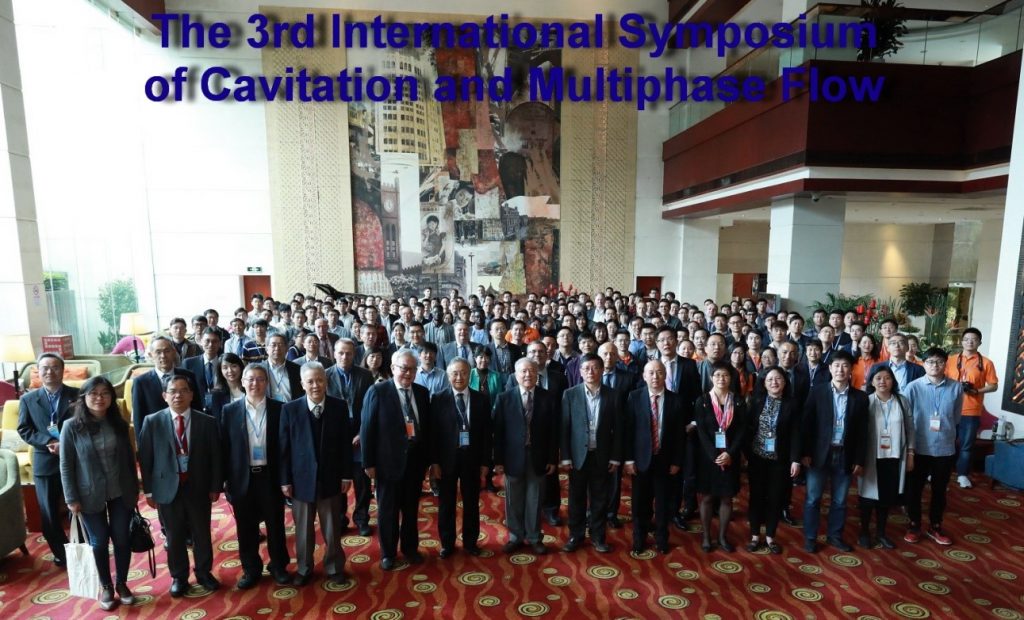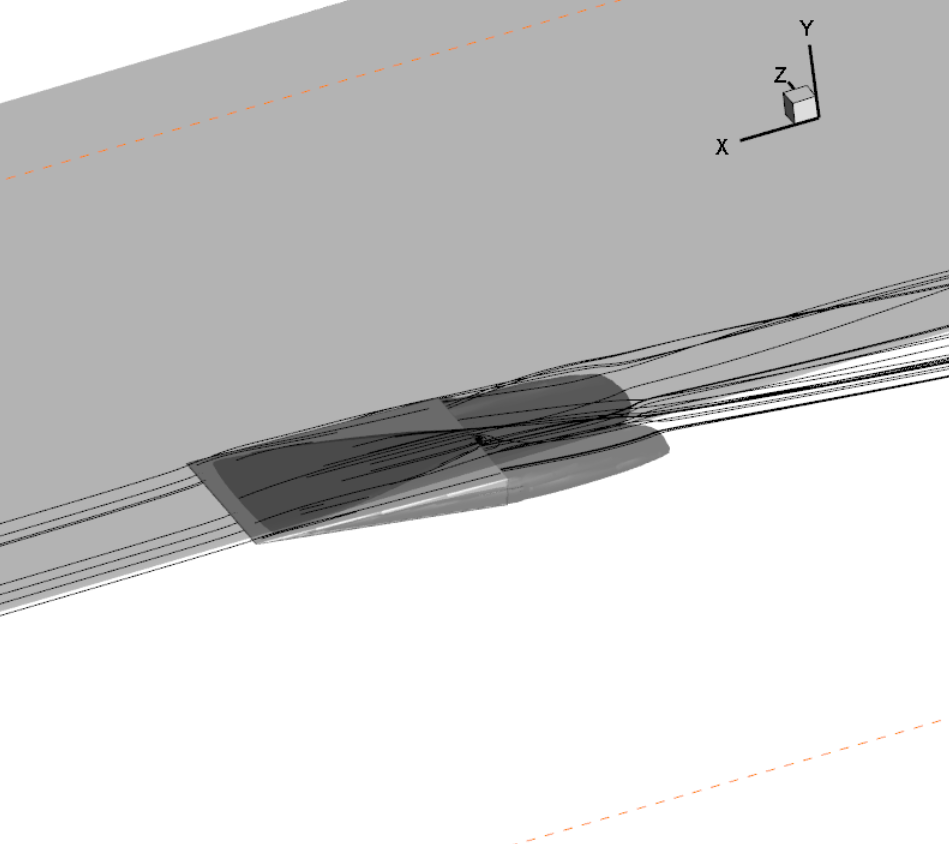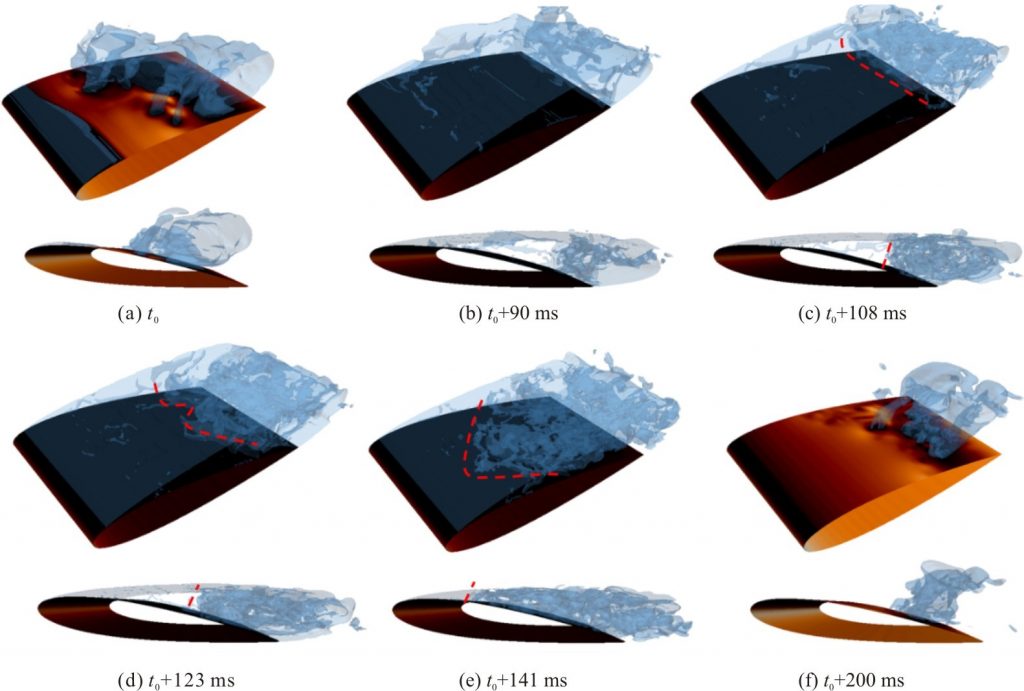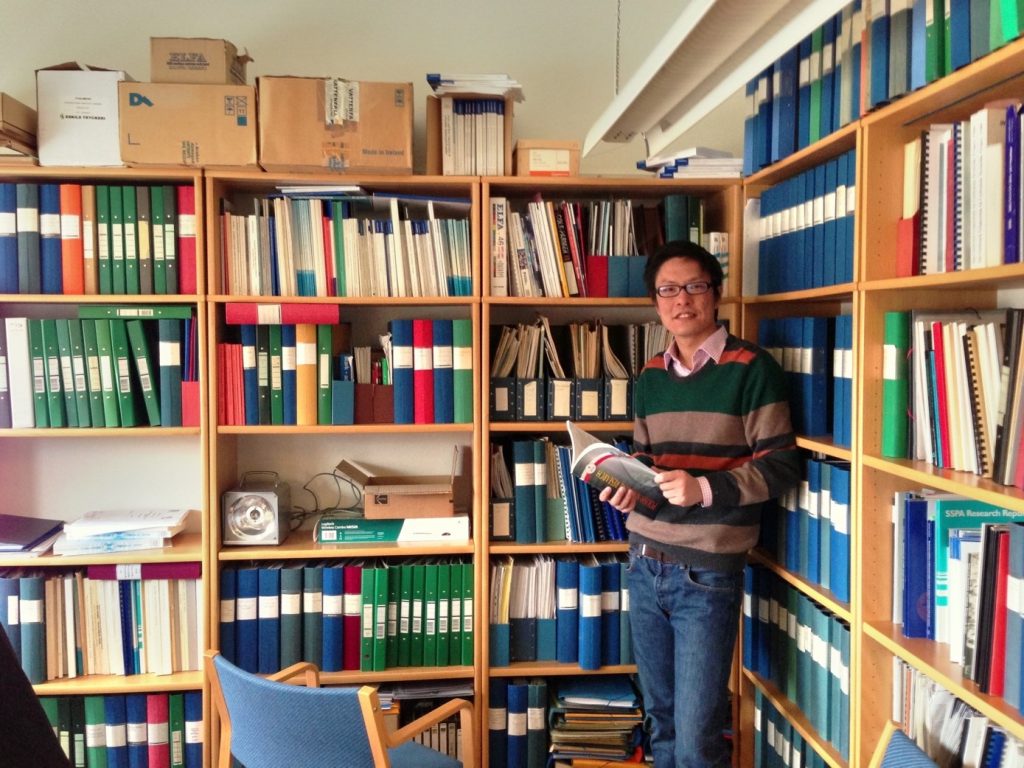Guidelines for Review Articles
1. More than 10 related papers have been published in this field.
2. The review articles must be cutting-edge. The thesis should not only comment on the scientific research results related to one’s own research, but explain the latest research status in this field from a global perspective. The literature review is not a comprehensive copy of the literature, it is not a simple listing of the literature, but a review of the cited papers as a senior expert, and the innovations and deficiencies of the results are proposed.
3. The review articles should be forward-looking. In addition to commenting on the existing results, the thesis should also give a special discussion on the development direction, research difficulties and development prospects of the field, which will lead and enlighten future scientific research. This is the essence of the review article.
Top Articles of JHD in 2019 (data from Springer-Nature)
| Top-Articles-of-JHD-in-2019-data-from-Springer-Nature.docx (3092 downloads) |
1.Top 10 Full-Text Article Requests 2019 (all publication years)
| Title | Author | Article Type | Volume | Issue | Year* | Article Requests 2019 | |
| 1 | Spectral/hp element methods: Recent developments, applications, and perspectives | Hui Xu et al. | Review Paper | 30 | 1 | 2018 | 1,662 |
| 2 | Third generation of vortex identification methods: Omega and Liutex/Rortex based systems | Chaoqun Liu et al. | Original Paper | 31 | 2 | 2019 | 487 |
| 3 | Application of deep learning method to Reynolds stress models of channel flow based on reduced-order modeling of DNS data | Zhen Zhang et al. | Original Paper | 31 | 1 | 2019 | 278 |
| 4 | Bubble dynamics and its applications | Shi-Ping Wang et al. | Review Paper | 30 | 6 | 2018 | 220 |
| 5 | A review of cavitation in hydraulic machinery | Xian-wu Luo et al. | Review Paper | 28 | 3 | 2016 | 195 |
| 6 | Development of naoe-FOAM-SJTU solver based on OpenFOAM for marine hydrodynamics | Jian-hua Wang et al. | Original Paper | 31 | 1 | 2019 | 181 |
| 7 | A selected review of vortex identification methods with applications | Yu-ning Zhang et al. | Original Paper | 30 | 5 | 2018 | 149 |
| 8 | Smoothed particle hydrodynamics and its applications in fluid-structure interactions | A-man Zhang et al. | Review Paper | 29 | 2 | 2017 | 136 |
| 9 | The structure of turbulent flow through submerged flexible vegetation | Wen-xin Huai et al. | Original Paper | 31 | 2 | 2019 | 135 |
| 10 | SPH modeling of fluid-structure interaction | Luhui Han et al. | Original Paper | 30 | 1 | 2018 | 130 |
2.Top 10 Full-Text Article Requests 2019 (publication years 2017–2019)
| Title | Author | Article Type | Volume | Issue | Year* | Article Requests 2019 | |
| 1 | Spectral/hp element methods: Recent developments, applications, and perspectives | Hui Xu et al. | Review Paper | 30 | 1 | 2018 | 1,662 |
| 2 | Third generation of vortex identification methods: Omega and Liutex/Rortex based systems | Chaoqun Liu et al. | Original Paper | 31 | 2 | 2019 | 487 |
| 3 | Application of deep learning method to Reynolds stress models of channel flow based on reduced-order modeling of DNS data | Zhen Zhang et al. | Original Paper | 31 | 1 | 2019 | 278 |
| 4 | Bubble dynamics and its applications | Shi-Ping Wang et al. | Review Paper | 30 | 6 | 2018 | 220 |
| 5 | Development of naoe-FOAM-SJTU solver based on OpenFOAM for marine hydrodynamics | Jian-hua Wang et al. | Original Paper | 31 | 1 | 2019 | 181 |
| 6 | A selected review of vortex identification methods with applications | Yu-ning Zhang et al. | Original Paper | 30 | 5 | 2018 | 149 |
| 7 | Smoothed particle hydrodynamics and its applications in fluid-structure interactions | A-man Zhang et al. | Review Paper | 29 | 2 | 2017 | 136 |
| 8 | The structure of turbulent flow through submerged flexible vegetation | Wen-xin Huai et al. | Original Paper | 31 | 2 | 2019 | 135 |
| 9 | Explicit formula for the Liutex vector and physical meaning of vorticity based on the Liutex-Shear decomposition | Yi-qian Wang et al. | Original Paper | 31 | 3 | 2019 | 130 |
| 10 | SPH modeling of fluid-structure interaction | Luhui Han et al. | Original Paper | 30 | 1 | 2018 | 130 |
3.Top ranking highest cited 2016-2017 articles for IF Year 2018
| Title | Author | Publication Type | Publication Date | DOI | Volume | Issue | Total Citations* | Citations for IF 2018 |
| A review of cavitation in hydraulic machinery | Luo, Xian-wu; Ji, Bin; Tsujimoto, Yoshinobu | Review | 01-06-2016 | 10.1016/S1001-6058(16)60638-8 | 28 | 3 | 95 | 25 |
| Smoothed particle hydrodynamics and its applications in fluid-structure interactions | Zhang, A-man; Sun, Peng-nan; Ming, Fu-ren; Colagrossi, A. | Review | 01-04-2017 | 10.1016/S1001-6058(16)60730-8 | 29 | 2 | 46 | 19 |
| Large eddy simulation of turbulent attached cavitating flow with special emphasis on large scale structures of the hydrofoil wake and turbulence-cavitation interactions | Ji, Bin; Long, Yun; Long, Xin-ping; Qian, Zhong-dong; Zhou, Jia-jian | Article | 01-02-2017 | 10.1016/S1001-6058(16)60715-1 | 29 | 1 | 40 | 19 |
| Verification and validation of URANS simulations of the turbulent cavitating flow around the hydrofoil | Long, Yun; Long, Xin-ping; Ji, Bin; Huai, Wen-xin; Qian, Zhong-dong | Article | 01-08-2017 | 10.1016/S1001-6058(16)60774-6 | 29 | 4 | 38 | 18 |
| On the modeling of viscous incompressible flows with smoothed particle hydrodynamics | Liu, Mou-Bin; Li, Shang-ming | Review | 01-10-2016 | 10.1016/S1001-6058(16)60676-5 | 28 | 5 | 40 | 16 |
| Mixed convection flow of jeffrey nanofluid with thermal radiation and double stratification | Abbasi, F. M.; Shehzad, S. A.; Hayat, T.; Alhuthali, M. S. | Article | 01-10-2016 | 10.1016/S1001-6058(16)60686-8 | 28 | 5 | 31 | 12 |
| Numerical simulation of hydraulic force on the impeller of reversible pump turbines in generating mode | Li, Jin-wei; Zhang, Yu-ning; Liu, Kai-hua; Xian, Hai-zhen; Yu, Ji-xing | Article | 01-08-2017 | 10.1016/S1001-6058(16)60773-4 | 29 | 4 | 13 | 8 |
| Hull form optimization of a cargo ship for reduced drag | Huang, Fuxin; Yang, Chi | Article | 01-04-2016 | 10.1016/S1001-6058(16)60619-4 | 28 | 2 | 21 | 7 |
| Numerical investigation of unsteady cavitating turbulent flows around twisted hydrofoil from the Lagrangian viewpoint | Cheng, Huai-yu; Long, Xin-ping; Ji, Bin; Zhu, Ye; Zhou, Jia-jian | Article | 01-08-2016 | 10.1016/S1001-6058(16)60674-1 | 28 | 4 | 19 | 6 |
| Hydrodynamic modelling of flow impact on structures under extreme flow conditions | Liang, Qiuhua; Chen, Kai-cui; Hou, Jingming; Xiong, Yan; Wang, Gang; Qiang, Juan | Article | 01-04-2016 | 10.1016/S1001-6058(16)60628-5 | 28 | 2 | 11 | 6 |
4.Altmetric Top 10 – 2019
How is the Altmetric score calculated? The score is a weighted count
The score is a weighted count of the different sources (newspaper stories, tweets, blog posts, comments) that mention the paper.
Why is it weighted? To reflect the relative importance of each type of source. It’s easy to imagine that the average newspaper story is more likely to bring attention to the paper than the average tweet. This is reflected in the default weightings.
| News | Blogs | Q&A forums | Google+ | |||||||
| 8 | 5 | 2.5 | 1 | 1 | 0.25 | |||||
| Score | Article DOI | Title | Author(s) | Publication Date | ||||||
| 8 | 10.1016/s1001-6058(09)60249-3 | Dynamic pressures on curved front seawall models under random waves | K. V. ANAND, V. SUNDAR, S. A. SANNASIRAJ | 01-10-2010 | ||||||
| 4 | 10.1016/s1001-6058(16)60614-5 | A new biomimicry marine current turbine: Study of hydrodynamic performance and wake using software OpenFOAM | YUNG-JEH CHU | 01-02-2016 | ||||||
| 3 | 10.1016/s1001-6058(13)60365-0 | Influence of emergent macrophyte (Phragmites australis) density on water turbulence and erosion of organic-rich sediment | JUKKA HORPPILA, JONI KAITARANTA, LAURA JOENSUU, LEENA NURMINEN | 01-04-2013 | ||||||
| 3 | 10.1016/s1001-6058(16)60791-6 | Numerical simulation of three-dimensional breaking waves and its interaction with a vertical circular cylinder | ZHIHUA XIE, LIN LU, THORSTEN STOESSER, JIAN-GUO LIN, DIMITRIOS PAVLIDIS, PABLO SALINAS, CHRISTOPHER C. PAIN, OMAR K. MATAR | 01-10-2017 | ||||||
| 2 | 10.1016/s1001-6058(16)60705-9 | Effects of thermal boundary conditions on the joule heating of electrolyte in a microchannel | M. Y. ABDOLLAHZADEH JAMALABADI, J. H. PARK, M. M. RASHIDI, J. M. CHEN | 01-10-2016 | ||||||
| 1 | 10.1016/s1001-6058(16)60699-6 | New prospects for computational hydraulics by leveraging high-performance heterogeneous computing techniques | QIUHUA LIANG, LUKE SMITH, XILIN XIA | 01-12-2016 | ||||||
| 1 | 10.1016/s1001-6058(16)60628-5 | Hydrodynamic modelling of flow impact on structures under extreme flow conditions | QIUHUA LIANG, KAI-CUI CHEN, JINGMING HOU, YAN XIONG, GANG WANG, JUAN QIANG | 01-04-2016 | ||||||
海洋工程中圆柱体的流致振动研究进展
2020年5月,广东虎门大桥发生的流致振动(Flow-induced Vibration, FIV)事件使大众对FIV的关注度急剧上升,也让人马上联想起震惊世界的1940年塔科马大桥的垮塌事件(图1)。众所周知,钝体绕流会产生卡门涡街,其泄涡频率与结构固有频率接近时容易产生涡激振动(VIV)。这可能诱发结构的疲劳破坏,导致结构的安全事故。为了减弱甚至消除这种VIV,在海洋工程领域,人们发明了各种抑制装置,在实际工程中有着广泛应用。近10来年的研究发现,在圆柱结构附加整流罩或分离盘这样的附加结构在一些条件下有很好的VIV抑制作用;然而,在另一些条件下,可能发生比VIV振幅更大,类似于土木桥梁领域方柱结构的驰振(Galloping)现象,这种驰振反而加强振动,加剧破坏。需要我们深入思考和研究这些抑制装置的作用机理,探讨新的FIV抑制装置。
本期栏目中,我们推荐上海交通大学王嘉松教授团队与麻省理工学院机械工程范迪夏博士,在Journal of Hydrodynamics第32卷第3期(2020)发表的关于“海洋工程中圆柱体的流致振动问题”综述文章 A review on flow-induced vibration of offshore circular cylinders(share this artilce: https://rdcu.be/b5u8I)。
图1 (来源于网络)虎门大桥(2020)和塔科马大桥(1940)的流致振动
该文以“单柱体VIV→复杂多柱体WIV→工程抑制与驰振”为主线,由简单到复杂,由抽象模型到实际应用,由实验室和数值研究到工业界实践,翔实地梳理阐述了10多年来学界与业界在海洋工程中圆柱体的FIV问题研究上的进展。
(1)单柱体VIV:强调流固耦合问题的复杂度
FIV中广泛存在着流固耦合(FSI)现象,即结构在流体载荷下发生变形或运动,同时结构又对流场分布产生影响,流固二者相互作用相互影响。FIV的FSI机理还没有被完全阐明,其背后存在着的如附加质量、高阶流体力等问题仍有待进一步研究。FSI的高度复杂性为实验和数值研究提出了诸多挑战。
从刚性结构到柔性结构,从强迫振动到自由振动,FSI的复杂程度逐渐加深。文章对基于三种基本模型的单柱VIV研究做了归纳:(1)受弹性支撑的刚性圆柱;(2)做强迫振动的刚性圆柱;(3)做自由振动的柔性圆柱(图2)。揭示了在均匀来流作用下的刚性圆柱以及柔性圆柱的复杂表现和内在机理,建立了三种基本模型之间的联系。
图2 柔性单管自由振动(左-模型尺度,右-实尺度)
(2)多柱体WIV:总结多柱体结构的流动干涉及流固耦合响应干涉特征
在海洋工程中,许多FIV问题涉及到由两个或两个以上圆柱体组成的柱群或者管丛结构,比如用于海上钻井和生产平台的立管阵列。当流体流经这些近距布置的多管柱体结构时,结构的尾流之间会发生流动干涉形成复杂尾涡形态。若结构可发生变形或位移响应时,尾流与结构间发生再耦合也会导致引起与单圆柱体VIV响应截然不同的结构响应(图3)。
文章从三个方面对柱群FIV干涉的研究作了总结:(1)固定圆柱体的流动干涉形态;(2)上游尾流与下游结构再耦合响应-WIV;(3)典型布置方式下多管柱结构FIV干涉响应特征。
图3 双管FIV干涉(左-模型尺度梯度流,右-实尺度均匀流)
(3)VIV抑制与驰振: 指出传统的抑制措施可能引起galloping,一种更不利的振动
在FIV的作用下,细长海洋结构物发生周期性振动,这会导致静载的增加和严重的疲劳破坏,通过在柱体上适当地附属抑振装置可以抑制这种振动。文章首次收集国内外数据对三种最常用的抑振装置:螺旋列板(helical strake)、整流罩(fairing)和分离盘(splitter plate)的抑制效果做了归纳(图4),表明各有优缺点,有的振幅抑制佳,却加大了曳力;有的曳力和振幅都小,但有时可能导致新的负面影响。尽管附属抑振装置的方法在大量工程领域得到了有效应用,但是研究发现,在某些情况下附属抑振装置可能会导致驰振,反而增大振幅。无论是与固有频率的关系,还是振动幅值的大小,这种驰振与传统的VIV有着本质的不同,它可能是锁頻(空气中),也可能低频(水中),可能是自激的(大约化速度启动),也可能是他激的(与VIV耦合),等等,这些机制有待我们深入研究。从另一角度来看,涡激振动或驰振还可通过能量转化加以获取及利用。
 图4 常见VIV抑制装置的效果
图4 常见VIV抑制装置的效果
(4)文章在最后给出了5点研究展望,表明挑战与机遇并存:
- 实验与观察仍然是“追本溯源”的核心手段,高精度和高效的CFD方法将成为“追实求真”核心机理和实际工程预报的更受期待的重要工具;
- 在大长细比、临界/超临界雷诺数、双自由度的实尺度柔性立管或多管等方面亟待进一步研究;
- 继续挖掘传统抑制方法,探索新型抑振方法,研究各种参数以及流动状态对VIV、WIV甚至galloping抑制效果的影响,通过合理布置抑振方案,在工程实践上消除或减弱结构物的振动;
- 人工智能/机器学习技术的发展与应用丰富了流体力学的研究方法,带来了研究方式的转变,使得探索广泛的参数空间成为可能;
- 最后,期待将研究成果转化到工业应用领域,比如为立管在其整个使用寿命内提供准确的响应预测。
作者简介:
 王嘉松 上海交通大学船建学院长聘教授,博士生导师,上海市闵行区领军人才。主要从事高精度数值计算方法及其应用,涡激振动机理及其抑制,流致振动及驰振,流固耦合,风洞与水槽实验,大气环境动力学等方向的研究,近来也从事流致振动能量获取的研究。作为负责人获上海科技进步一等奖,主要参与者获得中国石油化工联合会科技进步一等奖。担任《Journal of Hydrodynamics》和《水动力学研究与进展》编委。
王嘉松 上海交通大学船建学院长聘教授,博士生导师,上海市闵行区领军人才。主要从事高精度数值计算方法及其应用,涡激振动机理及其抑制,流致振动及驰振,流固耦合,风洞与水槽实验,大气环境动力学等方向的研究,近来也从事流致振动能量获取的研究。作为负责人获上海科技进步一等奖,主要参与者获得中国石油化工联合会科技进步一等奖。担任《Journal of Hydrodynamics》和《水动力学研究与进展》编委。
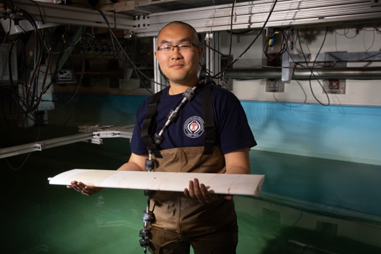 范迪夏 加拿大皇后大学机械与材料工程助理教授,他在2019年获得麻省理工学院机械学院的博士学位,2019-2020任麻省理工学院助理研究员。其主要的研究兴趣为流固耦合,漩涡流体的控制与感知以及仿生流体在船舶操纵上的应用。
范迪夏 加拿大皇后大学机械与材料工程助理教授,他在2019年获得麻省理工学院机械学院的博士学位,2019-2020任麻省理工学院助理研究员。其主要的研究兴趣为流固耦合,漩涡流体的控制与感知以及仿生流体在船舶操纵上的应用。
空化和多相流国际会议精选专栏
空化和多相流是流体力学的一个重要课题,也是实现装备系统稳定性、安全可靠性的重要问题。为加强交流以共同促进空泡、空化及相关多相流动的研究,2019年4月19日至4月22日,在上海召开了第三届空化和多相流国际会议(The 3rd International Symposium of Cavitation and Multiphase Flow, ISCM2019)。旨在为国内外专家及青年学者搭建合作平台,交流空化和多相流领域的最新研究成果及其应用,共同探索学术难题。同时,促进水动力学与重大工程/重要装备的相互融合与提高。
本次会议由上海大学、《水动力学研究与进展》编委会联合主办,北京国际力学中心、喷水推进技术重点实验室等多家单位协办单位。 来自意大利国家研究委员会罗马海洋工程研究所、日本东北大学和早稻田大学、荷兰特温特大学、西班牙加泰罗尼亚大学、斯洛文尼亚卢布尔雅那大学以及清华大学等国内高校研究所,近200名专家学者出席了此次研讨会。
美国工程院院士、加利福尼亚大学Said Elghobashi教授、英国伦敦帝国理工大学Yannis Hardalupas教授、新加坡国立大学Khoo Boo Cheong教授、德国马格德堡大学Claus-Dieter Ohl教授、法国国家科学研究中心Pierre-Yves Lagrée教授、瑞典Chalmers 理工大学Rickard Bensow教授、美国密歇根大学的Steven Ceccio教授、中国船舶科学研究中心的彭晓星研究员以及浙江大学林建忠教授等国内外知名学者,给参会者做了精彩的特邀报告。此外,为期三天的研讨会上,还设置了多场专题讨论,涉及水力机械内部空化多相流、空化及多相流数值计算与实验、空化多相流冲蚀及防冲蚀技术、空化与多相流诱导的流固耦合、空化流和多相流的多尺度模拟、空化产生的冲击波和微射流、气泡和汽泡的非线性振荡等,使得学者们在浓郁的气氛中得以充分的交流和研讨。本次大会形式多样、内容丰富、讨论气氛活跃。
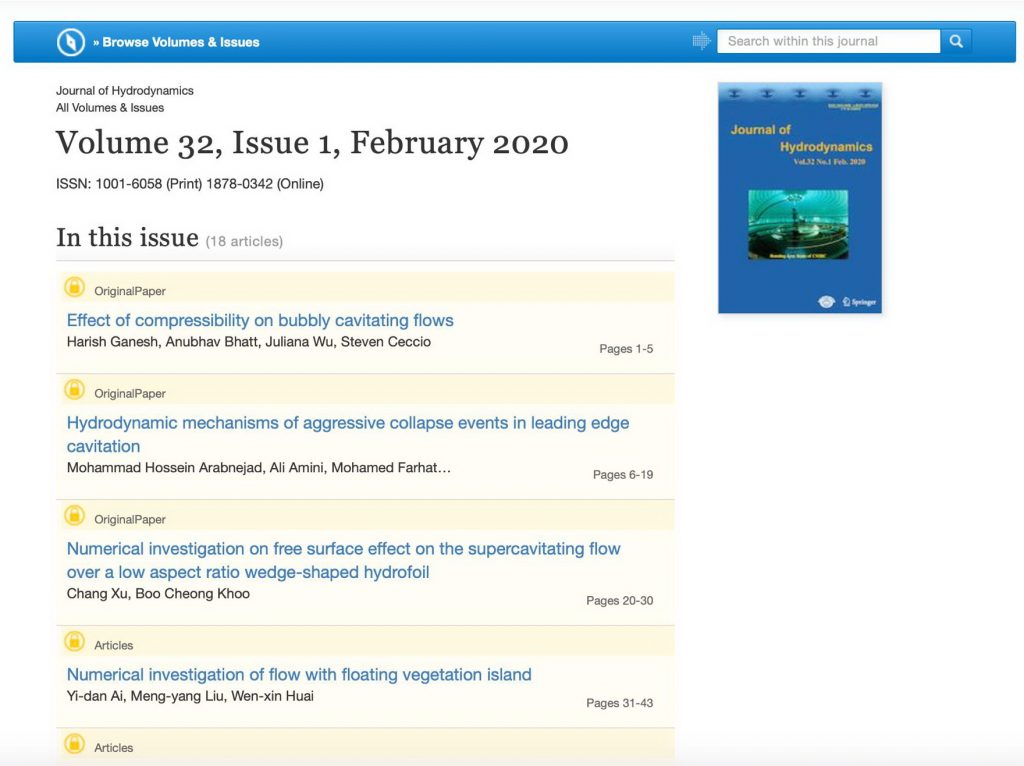 会议从大会邀请报告中选取了三篇论文在Journal of Hydrodynamics上作为专栏进行了发表(https://link.springer.com/journal/42241/32/1),
会议从大会邀请报告中选取了三篇论文在Journal of Hydrodynamics上作为专栏进行了发表(https://link.springer.com/journal/42241/32/1),
第一篇由美国密歇根大学的Steven Ceccio教授提供,《Effect of Compressibility on Bubbly Cavitating Flows 》(share this artilce: https://rdcu.be/b5u8I)介绍了泡状空化流动中的压缩性效应。该文指出泡状空化流动中存在大量的气泡使得本地声速较低,易形成超声速流动。作者在不同的几何形状的绕流问题中均发现了泡状激波(bubbly shocks),并指出泡状激波是空化流动失稳的重要原因。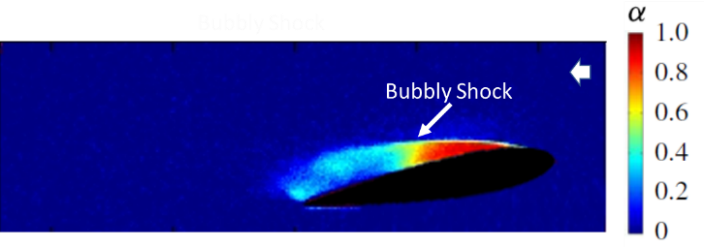 第二篇由瑞典Chalmers University of Technology的Rickard E Bensow教授提供,《Hydrodynamic mechanisms of aggressive collapse events in leading edge cavitation 》(share this artilce:https://rdcu.be/b5u8N )介绍了Naca0009水翼前缘局部空化结构溃灭的实验与数值模拟研究。通过比较发现可压缩求解器可以较好的获取瞬态空化流动结构中的溃灭现象,在此基础上利用计算了空化结构溃灭形成的侵蚀力,计算结果与油膜法空蚀实验获取的图案有很强的相关性,并发现了四个空蚀风险高的区域。
第二篇由瑞典Chalmers University of Technology的Rickard E Bensow教授提供,《Hydrodynamic mechanisms of aggressive collapse events in leading edge cavitation 》(share this artilce:https://rdcu.be/b5u8N )介绍了Naca0009水翼前缘局部空化结构溃灭的实验与数值模拟研究。通过比较发现可压缩求解器可以较好的获取瞬态空化流动结构中的溃灭现象,在此基础上利用计算了空化结构溃灭形成的侵蚀力,计算结果与油膜法空蚀实验获取的图案有很强的相关性,并发现了四个空蚀风险高的区域。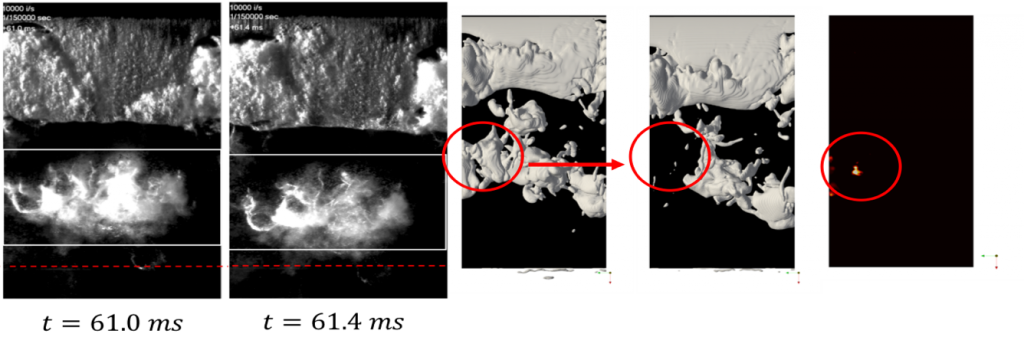 第三篇由新加坡国立大学的Khoo Boo Cheong教授提供,《Numerical Investigation on Free Surface Effect on the Supercavitating Flow over a Low Aspect Ratio Wedge-Shaped Hydrofoil》(share this artilce:https://rdcu.be/b5u8T) 介绍了近自由液面处超空泡流动的数值模拟研究。分析了浸没深度及水翼的长宽比对自由液面及超空泡形态的影响,同时获取了不同的流动图案及涡结构。
第三篇由新加坡国立大学的Khoo Boo Cheong教授提供,《Numerical Investigation on Free Surface Effect on the Supercavitating Flow over a Low Aspect Ratio Wedge-Shaped Hydrofoil》(share this artilce:https://rdcu.be/b5u8T) 介绍了近自由液面处超空泡流动的数值模拟研究。分析了浸没深度及水翼的长宽比对自由液面及超空泡形态的影响,同时获取了不同的流动图案及涡结构。
此外,本期中还另收录了两篇空化流动相关的快报,一篇由武汉大学的季斌博士提供,《Spatial and spectral investigation of turbulent kinetic energy in cavitating flow generated by Clark-Y hydrofoil》(share this artilce:htt://rdcu.be/b5u8W) 介绍了Clark-Y hydrofoil空化流动中湍流动能的时空分布特性,以及湍动能的频谱特征。另一篇由中国船舶与海洋设计研究院张伟博士提供,《Numerical simulation of condensation shock in partial cavitating flow on a hydrofoil》介绍了非稳态空化流动中凝聚激波的数值计算研究,提出了采用不可压缩求解器获取凝聚激波的方法,并显示了三维的空化流动结构。
客座编辑介绍:
张伟,中国船舶与海洋设计研究院,喷水推进技术重点实验室,高级工程师。主要从事流体力学、湍流与空化流动,以及人工智能及机器学习在流体学中的应用研究。担任Journal of hydrodynamics编委。
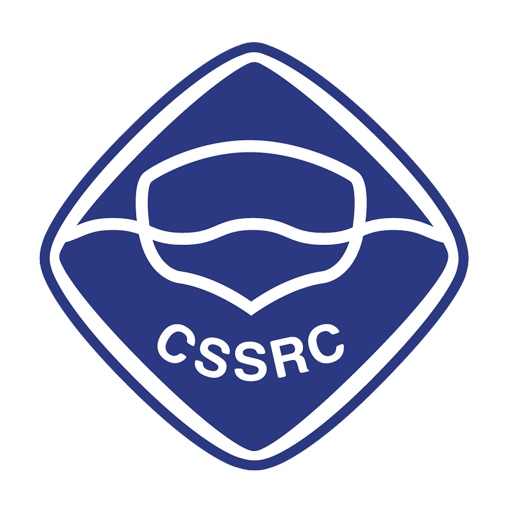

和塔科马大桥(1940)的流致振动(左边的图).gif)
和塔科马大桥(1940)的流致振动(右边的图).gif)
.gif)
.gif)
(左边的图).gif)
(右边的图).gif)
